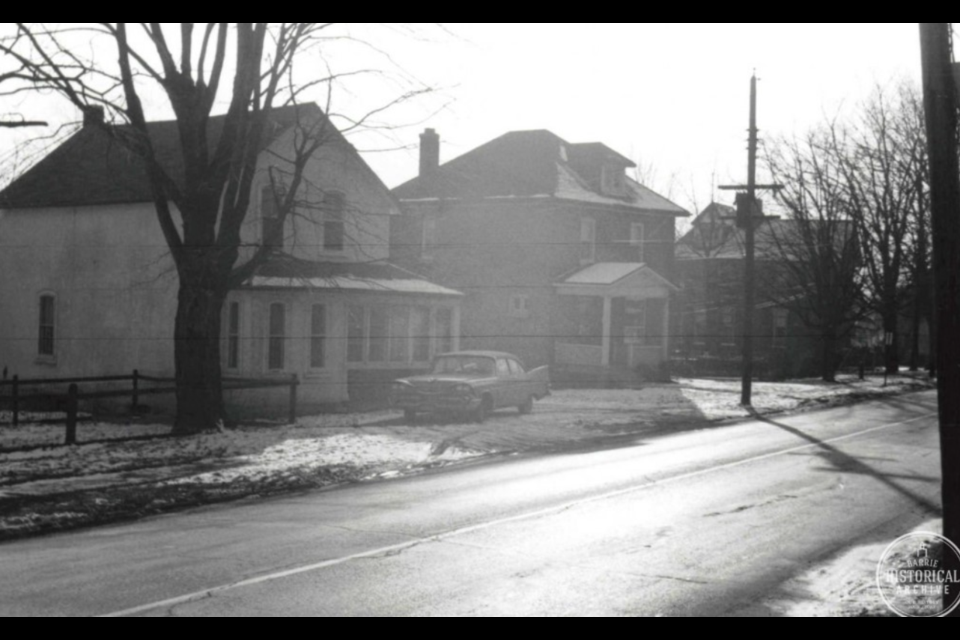The house at 245 Dunlop St. E. in Barrie is not extraordinary and the people who lived there some 90 years ago were not famous.
Still, I imagine that the inviting front porch area was the setting for many long discussions about the places the extended family had been.
The once plastered walls of this home are covered today with clean white siding and contrasting shutters. A large tree and a vintage car, shown in a 1965 photo, are long gone. That porch, waving distance from the sidewalk, was probably a favourite relaxation spot for resident Clarence Bowhey. Perhaps he liked to read a newspaper out there on his days off from his railway cashier job at the CNR station.
Clarence was born in 1893 near Fenelon Falls. His parents, John Henry Bowhey and Emily Stafford, had grown up on adjoining farms nearby. John Bowey had been, for a time, a section man on the railway.
When the Great War broke out, Clarence, too, was working on the railway. He was employed near King Station, and it was there that he signed on to fight on the battlegrounds of Europe in April 1916. On his return two-and-a-half years later, he moved to Barrie to continue his railway career. Clarence boarded at 29 McDonald St. and at 81 Mary St.
In 1922, Clarence married Michigan-born Perle Rowe. What was a Michigan girl doing in Barrie?
Perle’s people were no strangers to migration. Her surname had been changed from Rauh to Rowe by her German ancestors as they arrived in Quebec in the late 1700s. Perle’s great-grandfather had been one of the Hessian soldiers brought to America to fight for the British during the Revolutionary War. In the aftermath, many of the Hessians were welcomed into Canada.
Perhaps it was in his DNA. Perle’s father, Sylvester Charles Rowe, was not averse to relocating if necessary. By the 1850s, the Rowes were living northwest of Collingwood and engaged in farming. In 1885, Sylvester married Mary Fawcett and went into the innkeeping business.
Then, in 1901, Sylvester Rowe set off for Marmora Township in eastern Ontario to try a new line of work — gold mining. His timing might have been just a little bit off.
From the 1870s, Marmora Township had been the site of much activity as various gold and silver companies worked to extract precious minerals from the land. Sylvester Rowe arrived just in time to see all mine work shut down as these companies restructured.
Undeterred, and perhaps bitten by the gold bug, he set off for the farthest point in northern Michigan, the Keweenaw Peninsula, which juts out into Lake Superior. Much closer to Thunder Bay than Detroit, this place had been the site of Indigenous copper mining for centuries.
About this region, famous American geographer Henry Schoolcraft once said, “One cannot help fancying that he has gone to the ends of the earth, and beyond the boundaries appointed for the residence of man.”
Keweenaw copper was responsible for the first mineral rush in America, predating the big California Gold Rush of 1848.
It was to there that Sylvester Rowe brought his whole family. Perle Alexandra Rowe was born in Hancock, Mich., in 1903 as her father engaged in mining and prospecting nearby.
By 1911, the family was in Barrie and Sylvester Rowe was still working as a prospector. The family had settled in at 239 Dunlop St. E., which became convenient when Perle and her husband, Clarence Bowhey, moved into nearby 245 Dunlop St. E.
Each week, the Barrie Historical Archive provides BarrieToday readers with a glimpse of the city’s past. This unique column features photos and stories from years gone by and is sure to appeal to the historian in each of us.



